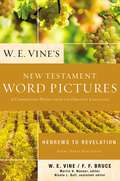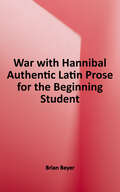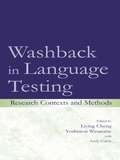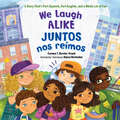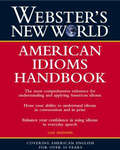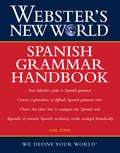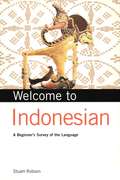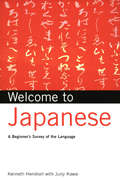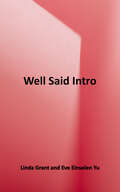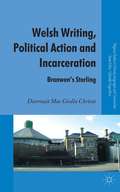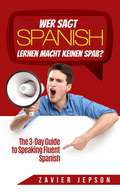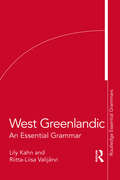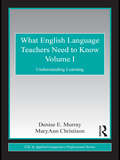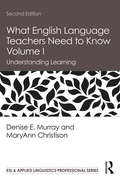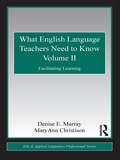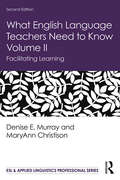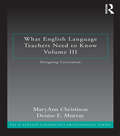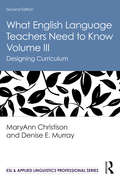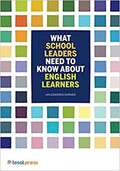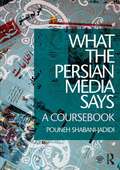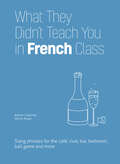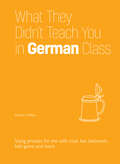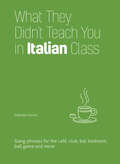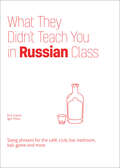- Table View
- List View
W. E. Vine's New Testament Word Pictures: A Commentary Drawn from the Original Languages
by W. E. VineStudy the meaning of biblical words in the original languages without spending years learning Greek. W. E. Vine's New Testament Word Pictures places every key word from Vine's classic Expository Dictionary of New Testament Words in Bible book and verse-by-verse order. The text of the King James Version of the Bible is included for context, but W. E. Vine's New Testament Word Pictures is keyed to the Strong's numbering system and can be used with any Bible translation.W. E. Vine's New Testament Word Pictures:Explains key words in original Greek contextDoes not require knowledge of GreekIncludes Strong's numbers for further studyIs ideal for busy Bible preachers and teachersCombines the features of a dictionary, concordance, and commentary
War With Hannibal: Authentic Latin Prose for the Beginning Student
by Brian BeyerThis edition of Book III of Eutropius's Breviarium ab urbe condita is designed to be a student's first encounter with authentic, unabridged Latin prose. Written in a simple and direct style, the Breviarium covers the period of Roman history that students find the most interesting—the Second Punic War fought against Carthage—and the original Latin text is supplemented with considerable learning support. Full annotations on every page, detailed commentary on grammar and syntax, and a glossary designed specifically for the text allow students to build both their confidence and their reading skills. <p><p>The commentary in the back of the book is cross-referenced to the following commonly used textbooks: <p>• Wheelock's Latin, 6th Edition <p>• Latin: An Intensive Course by Moreland and Fleischer <p>• Ecce Romani II, 3rd Edition - Latin for Americans, Level 2 <p>• Jenney's Second Year Latin <p>• Allen and Greenough's New Latin Grammar <p><p>Macrons have been added to the entire text in accordance with the vowel quantities used in the Oxford Latin Dictionary. Additional resources include an unannotated version of the text for classroom use, supplementary passages in English from other ancient authors, and appendixes with a timeline of events and maps and battle plans. <p><p>The text may be used in secondary schools and colleges as early as the first year of study. The copious translation help, notes, and cross-references also make it ideal for independent learners.
Washback in Language Testing: Research Contexts and Methods
by Liying Cheng Yoshinori Watanabe Andy CurtisWashback refers to the influence of language testing on teaching and learning. This volume, at the important intersection of language testing and teaching practices, presents theoretical, methodological, and practical guidance for current and future washback studies. In the field of language testing, researchers' major interest has traditionally been focused on issues and solving problems inherent in tests in order to increase their reliability and validity. However, the washback effect goes well beyond the test itself to include factors, such as curriculum, teacher and learner behaviors inside and outside the classroom, their perceptions of the test, and how test scores are used. Only recently have researchers started to empirically investigate the phenomenon of washback. This volume of such research serves two essential purposes by:*providing an overview of the complexity of washback and the various contextual factors entangled within testing, teaching, and learning; and *presenting empirical studies from around the world that offer insights into the effects of washback in specific educational contexts and models of research on which future studies can be based. The extensive use of test scores for various educational and social purposes in society nowadays makes the washback effect a high-interest phenomenon in the day-to-day educational activities of teachers, researchers, program coordinators/directors, policymakers, and others in the field of education. Washback in Language Testing: Research Contexts and Methods is a valuable resource for those who are interested in the application of findings to actual teaching and learning situations or conduct washback research in their own contexts, including educational and psychological testing experts, as well as alternative assessment people in all fields, and for policy- and decision-makers in educational and testing organizations.
We Laugh Alike / Juntos nos reímos: A Story That's Part Spanish, Part English, and a Whole Lot of Fun
by Carmen T. Bernier-GrandSix kids are ready to play: three speak English. Y tres hablan español [and three speak Spanish]. But all of them laugh alike and together! This clever playground adventure weaves together bilingual Spanish and English conversations, so two groups of children can express similar thoughts in their own languages.A brand new barrier-breaking and friendship-affirming bilingual picture book from award-winning author Carmen T. Bernier-Grand (Diego: Bigger than Life). Three kids are playing at the park when three more arrive. The groups can't understand each other because one trio speaks only English and the other only Spanish. But they can express similar thoughts in their own languages. Aquí interactúan el inglés y el español. Can they find a way to play? Of course they can! By watching each other, both groups learn that they are more alike than different and end up discovering new words and making new friends in this adventure propelled by clever integrated Spanish dialogue.
Webster's New World: American Idioms Handbook (Webster's New World)
by Gail BrennerThe most comprehensive reference for understanding and using the contemporary idioms of American English—with more than 1,000 entries. Mastering the use of idiomatic language is an essential step toward achieving fluency in any language. Webster's New World: American Idioms Handbook is the ideal guide to the slang, sayings, expressions, jargon, and colloquialisms of American English—covering more than 1,000 entries. Emphasizing acquisition and application, this book explains their meanings as well as when, where, why, and how to use them. A wealth of examples helps readers understand each idiom&’s connotation and identify its appropriate context. An extensive index allows for quick and easy reference.
Webster's New World: Spanish Grammar Handbook (Webster's New World)
by Gail SteinThis definitive guide to Spanish grammar covers all aspects of spoken and written Spanish from essential vocabulary to tense and mood conjugations. Webster&’s New World: Spanish Grammer Handbook is an essential resource for any Spanish language learner. Divided into fifteen chapters, it covers everything from basic necessities such as numbers, dates, and weather, to more complex forms of expression such as comparisons, idioms, and the subjunctive mood. Covering vocabulary, conjugation, tenses, moods, and much more, this complete guide will help you hone your Spanish speaking and writing skills. Organized so you can proceed at your own pace and review as needed, Webster's New World Spanish Grammar Handbook helps you progress from vocabulary to proficiency so you can communicate confidently in both social and business situations.
Welcome to Indonesian
by Stuart RobsonThis is a concise and user-friendly introduction to the Indonesian languageThis concise book aims to introduce the reader to the Indonesian language not by creating a course, with grammar and exercises, but by describing it from various points of view, such as telling what it is related to and how it has developed, and on this basis saying where some of its words originate, as a means of familiarization with some common examples. After that, the description moves on to talk about the kinds of words one wold expect to meet, and how they can be put together as sentences, before providing a few examples of journalistic prose as well as some more literary specimens, in order to give a feeling for the language. Welcome to Indonesian includes:Chapter 1: What is Indonesian?Chapter 2: Bahasa Indonesia as the National LanguageChapter 3: A Historical OverviewChapter 4: The Development of Modern IndonesianChapter 5: Indonesian and MalaysianChapter 6: The colloquial Dimension, Influence of Dialek JakartaChapter 7: What is Indonesian Related to?Chapter 9: Loanwords in Indonesian Chapter 10: The Indonesian WordChapter 11: The Indonesian SentenceChapter 12: Journalistic ProseChapter 13: A Literary DimensionSuggestions for Further ReadingGlossary of Indonesian Words
Welcome to Indonesian
by Stuart RobsonThis is a concise and user-friendly introduction to the Indonesian languageThis concise book aims to introduce the reader to the Indonesian language not by creating a course, with grammar and exercises, but by describing it from various points of view, such as telling what it is related to and how it has developed, and on this basis saying where some of its words originate, as a means of familiarization with some common examples. After that, the description moves on to talk about the kinds of words one wold expect to meet, and how they can be put together as sentences, before providing a few examples of journalistic prose as well as some more literary specimens, in order to give a feeling for the language. Welcome to Indonesian includes:Chapter 1: What is Indonesian?Chapter 2: Bahasa Indonesia as the National LanguageChapter 3: A Historical OverviewChapter 4: The Development of Modern IndonesianChapter 5: Indonesian and MalaysianChapter 6: The colloquial Dimension, Influence of Dialek JakartaChapter 7: What is Indonesian Related to?Chapter 9: Loanwords in Indonesian Chapter 10: The Indonesian WordChapter 11: The Indonesian SentenceChapter 12: Journalistic ProseChapter 13: A Literary DimensionSuggestions for Further ReadingGlossary of Indonesian Words
Welcome to Japanese: A Beginners Survey of the Language
by Junji Kawai Kenneth G. HenshallThis is a concise and user-friendly introduction to the Japanese language.<P><P>Japanese has too often been treated by Westerners as an exotic curiosity, but the reality is that it is a functional language spoken as a mother tongue by more than 125 million people, and ranks as the ninth most spoken language in the world. In the present global age, an age characterized by a vast range of Japanese products including electronic games and anime, more and more Westerners are in one way or another interacting with Japan and Japanese people. But it is nonetheless fair to say that the language, while increasing in popularity as a subject of study, is still not as widely spoken among non-Japanese as we might expect.In this book we would therefore like to "demistify" Japanese, to show how the language is formed and used, and to encourage you to pursue the study of it. Of course it has its challenges, especially with regards to the writing system, but we try to put these in a balanced context. And we like to think that, by describing the various facets of the Japanese language to you, we thereby empower you with a degree of knowledge and familiarity.
Well Said Intro (Well Said, New Edition Series)
by Linda Grant Eve Einselen YuThe Well Said series is designed to improve the pronunciation and communication skills of beginner to advanced students from all language backgrounds. It offers a clear course plan covering the essential areas of pronunciation, including stress, rhythm, and intonation--features that research shows help students the most. Additionally, there are over fifty pages of supplemental activities focusing on consonant and vowel sounds. The Intro level of Well Said is a slower-paced course that introduces the most important pronunciation features at the beginning to low-intermediate level. A free Website for teachers and students includes the full audio program.
Welsh Writing, Political Action and Incarceration: Branwen’s Starling (Palgrave Studies in Minority Languages and Communities)
by Diarmait Mac Giolla ChríostWelsh Writing, Political Action and Incarceration examines the prison literature of certain iconic Welsh authors whose political lives and creative writings are linked to ideas about Wales and the Welsh language, the nature of political activism, and the function of incarceration.
Wer sagt Spanisch lernen macht keinen Spaß?
by Zavier JepsonSuchen Sie nach einem Weg Ihr Spanisch zu verbessern und wollen Sie es so schnell wie möglich für Ihren nächsten Urlaub oder ihr nächstes Familientreffen lernen? Dann haben Sie genau das richitge Buch gefunden. Mit "Wer sagt Spanisch lernen macht keinen Spaß?" lernen Sie die Sprache in kürzester Zeit fließend. Mit den besonderen Lerntechniken können Sie die Sprache sogar innerhalb von drei Tagen lernen!
West Greenlandic: An Essential Grammar (Routledge Essential Grammars)
by Lily Kahn Riitta-Liisa ValijärviThis grammar provides a clear and comprehensive overview of contemporary West Greenlandic. It follows a systematic order of topics beginning with the alphabet and phonology, continuing with nominal and verbal morphology and syntax, and concluding with more advanced topics such as complex sentences and word formation. Grammatical points are illustrated with authentic examples reflecting current life in Greenland. Grammatical terminology is explained fully for the benefit of readers without a background in linguistics. Features include: Full grammatical breakdowns of all examples for ease of identifying individual components of complex words. A detailed contents list and index for easy access to information. An alphabetical list of the most commonly used West Greenlandic suffixes. A glossary of grammatical abbreviations used in the volume. The book is suitable for a wide range of users, including independent and classroom-based learners of West Greenlandic, as well as linguists and anyone with an interest in Greenland’s official language.
What English Language Teachers Need to Know Volume I: Understanding Learning
by Denise E. Murray MaryAnn ChristisonDesigned for pre-service teachers and teachers new to the field of ELT, What English Teachers Need to Know I and II are companion textbooks organized around the key question: What do teachers need to know and be able to do in order for their students to learn English? The focus throughout is on outcomes, that is, student learning. Volume I, on understanding learning, provides the background information that teachers need to know and be able to use in their classroom: the characteristics of the context in which they work how English works and how it is learned their role in the larger professional sphere of English language education Volume II, on facilitating learning, covers the three main facets of teaching: planning instructing assessing The texts work for teachers across different contexts (countries where English is the dominant language, one of the official languages, or taught as a foreign language); different levels (elementary/primary, secondary, college or university, or adult education), and different learning purposes (general English, workplace English, English for academic purposes, or English for specific purposes).
What English Language Teachers Need to Know Volume I: Understanding Learning (ESL & Applied Linguistics Professional Series)
by Denise E. Murray MaryAnn ChristisonDesigned for pre-service teachers and teachers new to the field of ELT, What English Teachers Need to Know Volumes I, II, and III are companion textbooks organized around the key question: What do teachers need to know and be able to do in order for their students to learn English? In the Second Edition of Volume I, Murray and Christison return to this essential question and call attention to emerging trends and challenges affecting the contemporary classroom. Addressing new skills and strategies that EFL teachers require to meet the needs of their shifting student populations who are impacted by changing demographics, digital environments, and globalization, this book, which is grounded in current research, offers a strong emphasis on practical applications for classroom teaching. This updated and expanded Second Edition features: a new chapter on technology in TESOL new and updated classroom examples throughout discussions of how teachers can prepare for contemporary challenges, such as population mobility and globalization The comprehensive texts work for teachers across different contexts—where English is the dominant language, an official language, or a foreign language; for different levels—elementary/primary, secondary, university, or adult education; and for different learning purposes—general English, workplace English, English for academic purposes, or English for specific purposes.
What English Language Teachers Need to Know Volume II: Facilitating Learning
by Denise E. Murray MaryAnn ChristisonDesigned for pre-service teachers and teachers new to the field of ELT, Volume II and its companion are companion textbook, Volume I, are volumes organized around the key question: What do teachers need to know and be able to do in order for their students to learn English? Volume I covers the characteristics of the context in which teachers work, how English works and how it is learned, and the teacher’s role in the larger professional sphere of English language education. Volume II covers the three main facets of teaching: planning, instructing, and assessing. The focus throughout is on outcomes, that is, student learning. The texts work for teachers across different contexts (countries where English is the dominant language, one of the official languages, or taught as a foreign language); different levels (elementary/primary, secondary, college or university, or adult education), and different learning purposes (general English, workplace English, English for academic purposes, or English for specific purposes).
What English Language Teachers Need to Know Volume II: Facilitating Learning (ESL & Applied Linguistics Professional Series)
by Denise E. Murray MaryAnn ChristisonDesigned for pre-service teachers and teachers new to the field of ELT, Volume II of the What English Language Teachers Need to Know set covers the three main facets of teaching: planning, instructing, and assessing. Updated with new research throughout, the focus throughout is on outcomes, that is, student learning. The texts work for teachers across different contexts; different levels, and different learning purposes. The Second Edition has expanded to address corpus-based data, new technologies, and a wider range of contexts.
What English Language Teachers Need to Know Volume III: Designing Curriculum
by MaryAnn Christison Denise E. MurrayWhat English Teachers Need to Know, a set of companion texts designed for pre-service teachers and teachers new to the field of ELT, addresses the key question: What do English language teachers need to know and be able to do in order for their students to learn English? These texts work for teachers across different contexts (countries where English is the dominant language, one of the official languages, or taught as a foreign language); different levels (elementary/primary, secondary, college or university, or adult education); and different learning purposes (general English, workplace English, English for academic purposes, or English for specific purposes). Volume I, on understanding learning, provides the background information that teachers need to know and be able to use in their classroom. Volume II, on facilitating learning, covers the three main facets of teaching: planning, instructing, and assessing. Volume III, on designing curriculum, covers the contexts for, processes in, and types of ELT curricula—linguistic based, content-based, learner-centered, and learning-centered. Throughout the three volumes, the focus is on outcomes, that is, student learning. Features • Situated in current research in the field of English language teaching and other disciplines that inform it • Sample data, including classroom vignettes • Three kinds of activities/tasks: Reflect, Explore, and Expand
What English Language Teachers Need to Know Volume III: Designing Curriculum (ESL & Applied Linguistics Professional Series)
by MaryAnn Christison Denise E. MurrayDesigned for pre-service and novice teachers in ELT, What English Language Teachers Need to Know Volumes I, II, and III are companion textbooks organized around the key question: What do teachers need to know and be able to do in order to help their students to learn English?Thoroughly revised and updated, the second edition of Volume III explores the contexts for ELT curricula; explains key processes in curriculum design; and sets out approaches to curricula that are linguistic-based, content-based, learner centered, and learning centered. Organized around the three pillars of teaching—planning, instructing, and assessing—chapters in the second edition are updated to include current research and theory to meet the needs of today’s teachers, and feature new or revised vignettes and activities. New chapters help teachers understand both the technological and multilingual approaches that learners need to succeed today. The comprehensive texts of this series are suitable resources for teachers across different contexts—where English is the dominant language, an official language, or a foreign language; for different levels—elementary/primary, secondary, university, or adult education; and for different learning purposes—general English, workplace English, English for academic purposes, or English for specific purposes.
What School Leaders Need to Know About English Learners
by Jan DormerSchool leaders have the unique opportunity and responsibility to play a crucial role in creating a culture of high expectations and an environment of support so that English language learners can succeed and continue to enrich the fabric of our country. <p><p> What School Leaders Need to Know About English Learners offers school leaders the foundation, the ideas, and the strategies to not only improve outcomes for English language learners, but to create rich multicultural and multilingual school environments which benefit all students. This book equips school leaders with effective, research-based strategies and best practices to help both ESOL and content-area teachers succeed in their roles. Includes a Professional Development Guide and a rich array of "Grab and Go" online resources. Copublished with National Association of Secondary School Principals (NASSP).
What the Persian Media says: A Coursebook
by Pouneh Shabani-JadidiWhat the Persian Media Says: A Coursebook is a comprehensive and stimulating course for intermediate to advanced students of Persian. Presenting many exercises based on authentic Persian newspaper texts, the course thoroughly introduces students to the language of the news in Iran. Real cultural content is featured throughout and there is a strong focus on enabling students to gain familiarity with day-to-day modern Persian discourse. Features include: A wide range of interesting and challenging exercises presented throughout, including activities designed to both test students’ knowledge in a classroom setting and to search online for further Persian news resources Usage of authentic texts from the Iranian media, written for native speakers, with sources including Ettel?’?t, Keyh?n, Sharq, E’tem?d, Ir?n, and Mardoms?l?ri Coverage of topics highly relevant to modern day Persian society, including the Arts, divorce, violence, problems of youth, unemployment, politics and economic issues, enabling cultural engagement and knowledge of complex expressions and idioms used in the media A comprehensive bilingual glossary of journalistic and non-journalistic terminology used in the newspaper texts, provided at the back of the book for easy access All the newspaper texts and their corresponding audio files available for free download at http://routledgetextbooks.com/textbooks/9781138825567/ What the Persian Media Says combines modern and more traditional techniques of language teaching. With all the newspaper texts and their corresponding audio files available for free on the Routledge website, students can read the texts in digital form and listen to the audio while working on exercises in the book, enabling full and exciting engagement with the course materials. Written by an experienced instructor, this will be an invaluable resource for intermediate to advanced undergraduate and postgraduate students of Persian. It can also be used by self-learners and by instructors and students on intensive courses and summer language programs.
What They Didn't Teach You in French Class: Slang Phrases for the Cafe, Club, Bar, Bedroom, Ball Game and More
by Henry Rowe Adrien ClautrierSipping a café au lait at a sidewalk bistro...Getting down at Paris&’s hottest club...Cheering on Les Bleus at the stadium...Drop the textbook formality and chat with the locals in France&’s everyday language.• What&’s up? Ça va?• She&’s totally hot. Elle est bandante.• This party is lit! Cette bringue est enflammée!• That brie smells funky. Ce brie sent putain de drôle.• Wanna French kiss? On se roule une pelle?• That ref is a moron. L&’arbitre est un abruti.
What They Didn't Teach You in German Class: Slang Phrases for the Cafe, Club, Bar, Bedroom, Ball Game and More (Dirty Everyday Slang)
by Daniel ChaffeyDrinking a Hefeweizen at a Biergarten...Dancing at Berlin&’s hottest club...Cheering for the local soccer team at the Stadion...Drop the textbook formality and chat with the locals in Germany&’s everyday language.• What&’s up? Wie geht&’s?• He/She is a real hottie. Er/Sie ist eine ganz heiße Nummer.• What&’s on tap? Was gibt&’s vom Fass?• I ordered the Currywurst. Ich bin den Currywurst.• Do you wanna cuddle? Willst Du kuscheln?• Gooooooal! Toooooor!
What They Didn't Teach You in Italian Class: Slang Phrases for the Cafe, Club, Bar, Bedroom, Ball Game and More (Dirty Everyday Slang)
by Gabrielle EuvinoSipping espresso at a sidewalk café...Toasting a pint of birra in the piazza...Cheering for Azzurri at lo Stadio Olimpico...Drop the textbook formality and chat with the locals in Italy&’s everyday language.• What&’s up? Che c&’è?• I&’m so plastered. Sono demolito/a.• Do you wanna cuddle? Vuoi coccolarci?• Nice body! Che corpo!• I&’m friggin&’ starving. Ho una fame da morti.• Hey ref, you&’re a moron! Arbitro cretino!
What They Didn't Teach You in Russian Class: Slang Phrases for the Cafe, Club, Bar, Bedroom, Ball Game and More (Dirty Everyday Slang)
by Igor Fisun Erin CoyneGrubbing on pierogies at a a Russian deli...Pounding vodka shots at Moscow&’s hottest dance club...Cheering for the local hockey team at the stadium...Drop the textbook formality and chat with the locals in Russia&’s everyday language.• What&’s up? Как дела?• He&’s/She&’s a hottie. Он/Она красавчик/красотка.• Let&’s go get wasted. Пойдём побухать.• Goooooooaaaaaaal! Гоооооооол!• This is crappy vodka. Эта водка хреновая.• Let&’s have a quickie. Давай по быстрому.
